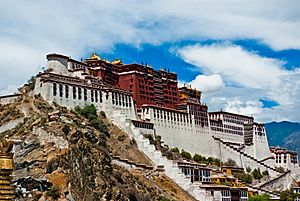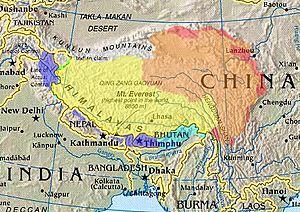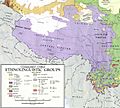Tibet facts for kids
The Xizang Autonomous Region, also known as the Tibet Autonomous Region (TAR), is a special area in China. Its capital city is Lhasa. Many English speakers call this region Tibet. However, the name Tibet can also mean any place where the unique Tibetan culture is found.
Contents
Exploring Tibetan Religion
The main religion in Tibet is Buddhism. Its traditions make Tibet a very interesting place for many people. Local monks are sometimes believed to have special abilities or deep wisdom. The writings of Tibetan monks often share important ideas. These ideas are known for their great insight.
The Tibetan Book of the Dead contains special practices for people who are dying or have passed away. These practices are somewhat like the special prayers in the Catholic Church for the dying. Some Tibetans also follow a religion called Bon. Experts who study Bon disagree about where it came from and how old it is. They also debate if it can be seen as a type of Buddhism.
The most important religious leader for Tibet's Buddhists is called the Dalai Lama. He had to leave Tibet when the Chinese Army took control. The Dalai Lama now lives in exile in India. He often travels to other countries. Many monks and other religious people also had to leave Tibet. They started Buddhist and Bon centers in cities all over the world.
A Look at Tibet's History
Tibet began with communities living along the Yarlung Tsangpo. This is the longest river in Tibet. Around 600 CE, Namri Songtsen united these groups under one king. Lhasa became the capital city. His son, Songtsen Gampo, took control of more land. He started the Tibetan Empire. Tibetan writers say that Buddhists first came to Tibet when Songtsen Gampo was king.
Trisong Detsen was king from 755 to 794 CE. He strongly supported Buddhism. He helped build a very important monastery at Samye. During Trisong Detsen's rule, the Tibetan Empire controlled huge areas. Tibet's borders reached Central Asia and Afghanistan in the west. They touched Bangladesh in the south and China in the east. After King Langdarma was killed in 842, the Tibetan Empire fell apart. Tibet was no longer united under one king.
The Tibetan Renaissance
In the late 900s and 1000s, new Buddhist and Bon traditions began. Three of the four main schools of Tibetan Buddhism were started then. The first Bon monasteries also appeared. People who study Tibet's past call this time the Tibetan Renaissance.
In 1042, the Indian Buddhist master Atisha came to Tibet. Atisha inspired big changes in Tibet's monasteries. He also wrote an important guide for people to reach enlightenment. These guides are called lamrim. All lamrim books in Tibet are based on Atisha's work. The largest school of Tibetan Buddhism, the Gelug school, was started by people inspired by Atisha. A key figure was the monk Tsongkhapa (1357-1419). Tsongkhapa's writings on philosophy became the main way of thinking in Tibet.
Tibet and Empires
The Mongol Empire sent armies to Tibet in 1240. They took control of the country over the next nine years. The Mongols let leaders from the Sakya school of Buddhism run Tibet. Tibetan Buddhism then spread to Mongolia. Today, most people in Mongolia are Buddhists because of this.
In the mid-1300s, Tibet became independent again. But the Mongols still had some power and influence. In 1577, the Mongol leader Altan Khan gave the leader of the Gelug school the title Dalai Lama. The fifth Dalai Lama managed to gain control of all of Tibet. The Dalai Lama became the leader not just of the Gelug school, but of all Tibet.
During the 1700s, the Qing Empire from China sent armies to Tibet. They took official control. However, the Qing emperors mostly let the Dalai Lama run the country. The Qing emperor Qianlong supported Tibetan Buddhism. He allowed new translations of Buddhist books to be made. He also helped build new temples.
In the late 1800s, the British Empire and Russian Empire became interested in controlling Tibet. This was because Tibet was located between Russian areas in Central Asia and British areas in India. Britain sent armies to Tibet in 1903-04. They forced Tibet to agree not to be friendly with Russia. A revolution ended the Qing Empire in 1911. Tibet became independent again and stayed independent for 36 years.
Modern Tibet and China
In 1949, Mao Zedong became the leader of China. Mao and other Chinese leaders believed China should control Tibet again. In 1950, Chinese troops entered eastern Tibet. Mao Zedong was a communist. He thought many things about how Tibetans lived should change. The Chinese communists did not like how much power the Dalai Lama, the Gelug school, and Buddhist groups had. They also wanted to change how land was owned in Tibet.
The changes made by the Communist Party of China were enforced with force. Tibetans began to fight back against the Chinese government. China responded by sending many troops in 1959. This forced the Dalai Lama and thousands of other Tibetans to flee to other countries. The Dalai Lama started a government in exile in India. Between 1959 and 1961, most of Tibet's monasteries were destroyed. The Chinese Communist Party gained full control over Tibetans' lives.
China created a special area called the Tibet Autonomous Region in 1965. However, ethnic Tibetans have not had much say in how this region is run. The Chinese government has encouraged many Han Chinese people to move to Tibet. Groups outside China, like Human Rights Watch, say that the Chinese government is treating Tibetans unfairly. They also say it is causing Tibetans to lose their culture.
How Tibet is Divided
Tibet is split into two municipalities (cities) and five autonomous prefectures (regions).
- Lhasa (拉萨)
- Xigaze (日喀则)
- Ngari Prefecture (阿里地区)
- Nagqu Prefecture (那曲地区)
- Chamdo Prefecture (昌都地区)
- Nyingchi Prefecture (林芝地区)
- Lhoka Prefecture (山南地区)
Tibet's Influence on Neighbors
Tibetan culture also has an impact on nearby regions. These include Nepal, Bhutan, parts of eastern Kashmir, and some areas in northern India. The most notable Indian areas are Sikkim, Uttaranchal, and Tawang. China claims part of the Indian province of Arunachal Pradesh as South Tibet.
Understanding Unrest in Tibet

There have been protests in Tibet since China took control in the 1950s. Most of these protests have been about social or economic problems. Some are also because people believe Tibet should not be part of China. To show their resistance, many Tibetans have set themselves on fire. They do this to pressure the Chinese government to let Tibet become independent again. In 2011, 19 people died this way.
A railway line, the Qingzang railway, has been built. It connects China to Lhasa. Also, rising food prices and difficulty getting higher education have made many people angry. The railway line also caused worries about more people moving into Tibet. This situation has led to some violence against people from outside Tibet. Some of this violence happens outside Tibet too.
When government jobs are given out in Tibet, more people from other Chinese groups seem to get them than Tibetans. The Chinese Government says that if Tibet became independent again, its economy would suffer.
Related pages
 |
Aksai Chin | Xinjiang (China) | Qinghai (China) |  |
| Pakistan India |
Sichuan (China) | |||
| Nepal< Sikkim |
Bhutan | Yunnan (China) Myanmar India |
Images for kids
-
Rishabhanatha, the founder of Jainism attained nirvana near Mount Kailash in Tibet.
-
The Mongol Yuan dynasty, c. 1294.
-
Putuo Zongcheng Temple, a Buddhist temple complex in Chengde, Hebei, built between 1767 and 1771. The temple was modeled after the Potala Palace.
-
Tibetan Plateau and surrounding areas above 1600 m – topography. Tibet is often called the "roof of the world".
-
Looking across the square at Jokhang temple, Lhasa
-
The Tibetan yak is an integral part of Tibetan life
-
A thangka painting in Sikkim
See also
 In Spanish: Tíbet para niños
In Spanish: Tíbet para niños


























